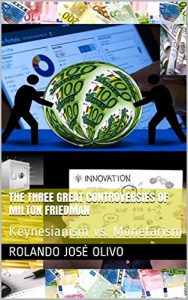After World War II, Keynesianism became the first economic current, being overtaken by Monetarism (in the mid-1970s and during the 1980s), and regaining its predominant role since the 1990s, motivated by the reformulation of Keynesian Theory and the acceptance of certain Monetarist foundations, and neo-Classical microeconomic principles. Nowadays, continues the leadership of neo-Keynesians in the formulation and implementation of economic policies.
The merits of Monetarists are awesome. They revealed the flaws of the Keynesian Theory, which forced the Keynesians to: modify some of their postulates, take into account the importance of monetary policies and recognize the need to grant autonomy to the central banks.
Moreover, the views of the main exponent of the Monetarism, the professor Milton Friedman, originated three major controversies (discussions that are still in force):
1. The objection to Theory of Economic Cycles.
2. The natural rate of unemployment.
3. The neutrality of money
CONTENT:
I. INTRODUCTION
II. KEYNESIANISM VS. MONETARISM
II.1 THE RISE AND FALL OF KEYNESIANISM
II.2 THE RISE OF MONETARISM
II.3 THE GROWTH OF MONETARISM
II 4 THE RISE OF NEO-KEYNESIANISM
III. THE GREAT CONTROVERSIES OF MILTON FRIEDMAN
III.1 THE OBJECTION TO THEORY OF ECONOMIC CYCLES
III.2 THE NATURAL RATE OF UNEMPLOYMENT
III.3 THE NEUTRALITY OF MONEY
IV. CONCLUSIONS
V. BIBLIOGRAPHY
The merits of Monetarists are awesome. They revealed the flaws of the Keynesian Theory, which forced the Keynesians to: modify some of their postulates, take into account the importance of monetary policies and recognize the need to grant autonomy to the central banks.
Moreover, the views of the main exponent of the Monetarism, the professor Milton Friedman, originated three major controversies (discussions that are still in force):
1. The objection to Theory of Economic Cycles.
2. The natural rate of unemployment.
3. The neutrality of money
CONTENT:
I. INTRODUCTION
II. KEYNESIANISM VS. MONETARISM
II.1 THE RISE AND FALL OF KEYNESIANISM
II.2 THE RISE OF MONETARISM
II.3 THE GROWTH OF MONETARISM
II 4 THE RISE OF NEO-KEYNESIANISM
III. THE GREAT CONTROVERSIES OF MILTON FRIEDMAN
III.1 THE OBJECTION TO THEORY OF ECONOMIC CYCLES
III.2 THE NATURAL RATE OF UNEMPLOYMENT
III.3 THE NEUTRALITY OF MONEY
IV. CONCLUSIONS
V. BIBLIOGRAPHY











